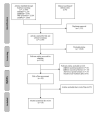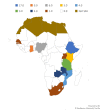How applicable is geospatial analysis in maternal and neonatal health in sub-Saharan Africa? A systematic review
- PMID: 35939400
- PMCID: PMC9359463
- DOI: 10.7189/jogh.12.04066
How applicable is geospatial analysis in maternal and neonatal health in sub-Saharan Africa? A systematic review
Abstract
Background: Sub-Saharan Africa (SSA) has the world's highest maternal and neonatal morbidity and mortality and has shown the slowest progress in reducing them. In addition, there is substantial inequality in terms of maternal and neonatal morbidity and mortality in the region. Geospatial studies can help prioritize scarce resources by pinpointing priority areas for implementation. This systematic review was conducted to explore the application of geospatial analysis to maternal and neonatal morbidity and mortality in SSA.
Methods: A systematic search of PubMed, SCOPUS, EMBASE, and Web of Science databases was performed. All observational and qualitative studies that reported on maternal or neonatal health outcomes were included if they used a spatial analysis technique and were conducted in a SSA country. After removing duplicates, two reviewers independently reviewed each study's abstract and full text for inclusion. Furthermore, the quality of the studies was assessed using the Joanna Briggs Institute (JBI) critical appraisal checklists. Finally, due to the heterogeneity of studies, narrative synthesis was used to summarize the main findings, and Preferred Reporting Items for Systematic Reviews and Meta-Analyses (PRISMA) guideline was strictly followed to report the review results. A total of 56 studies were included in the review.
Results: We found that geospatial analysis was used to identify inequalities in maternal and neonatal morbidity, mortality, and health care utilization and to identify gaps in the availability and geographic accessibility of maternal health facilities. In addition, we identified a few studies that used geospatial analysis for modelling intervention areas. We also detected challenges and shortcomings, such as unrealistic assumptions used by geospatial models and a shortage of reliable, up-to-date, small-scale georeferenced data.
Conclusions: The use of geospatial analysis for maternal and neonatal health in SSA is still limited, and more detailed spatial data are required to exploit the potential of geospatial technologies fully.
Copyright © 2022 by the Journal of Global Health. All rights reserved.
Conflict of interest statement
Disclosure of interest: The authors completed the ICMJE Disclosure of Interest F (available upon request from the corresponding author) and disclose no relevant interests.
Figures


Similar articles
-
Feasibility, acceptability, and effectiveness of group antenatal care on the continuum of care and perinatal outcomes in Sub-Saharan Africa: A systematic review and meta-analysis protocol.PLoS One. 2025 Apr 22;20(4):e0311473. doi: 10.1371/journal.pone.0311473. eCollection 2025. PLoS One. 2025. PMID: 40261892 Free PMC article.
-
Prevalence and factors associated with maternal and neonatal sepsis in sub-Saharan Africa: a systematic review and meta-analysis.Front Public Health. 2024 Jan 24;12:1272193. doi: 10.3389/fpubh.2024.1272193. eCollection 2024. Front Public Health. 2024. PMID: 38327574 Free PMC article.
-
Beyond the black stump: rapid reviews of health research issues affecting regional, rural and remote Australia.Med J Aust. 2020 Dec;213 Suppl 11:S3-S32.e1. doi: 10.5694/mja2.50881. Med J Aust. 2020. PMID: 33314144
-
Barriers and enablers of quality high-acuity neonatal care in sub-Saharan Africa: protocol for a synthesis of qualitative evidence.BMJ Open. 2024 Mar 19;14(3):e081904. doi: 10.1136/bmjopen-2023-081904. BMJ Open. 2024. PMID: 38508624 Free PMC article.
-
Barriers to access and utilization of emergency obstetric care at health facilities in sub-Saharan Africa: a systematic review of literature.Syst Rev. 2018 Nov 13;7(1):183. doi: 10.1186/s13643-018-0842-2. Syst Rev. 2018. PMID: 30424808 Free PMC article.
Cited by
-
Exploring spatiotemporal trends and impacts of health resources and services on under-5 mortality in West African countries, 2010-2019: a spatial data analysis.Front Public Health. 2023 Sep 13;11:1193319. doi: 10.3389/fpubh.2023.1193319. eCollection 2023. Front Public Health. 2023. PMID: 37771822 Free PMC article.
-
Impacts of seasonal flooding on geographical access to maternal healthcare in the Barotse Floodplain, Zambia.Int J Health Geogr. 2023 Jul 31;22(1):17. doi: 10.1186/s12942-023-00338-3. Int J Health Geogr. 2023. PMID: 37525198 Free PMC article.
-
Spatiotemporal patterns and factors contributing to neonatal mortality in Ethiopia: Data from EDHS 2000 to 2019.PLoS One. 2024 Nov 4;19(11):e0310276. doi: 10.1371/journal.pone.0310276. eCollection 2024. PLoS One. 2024. PMID: 39495721 Free PMC article.
-
Analysing space-time patterns of maternal mortality attributed to anaemia in Karnataka, India: a spatial epidemiological study.BMJ Public Health. 2024 Sep 23;2(2):e000590. doi: 10.1136/bmjph-2023-000590. eCollection 2024 Dec. BMJ Public Health. 2024. PMID: 40018549 Free PMC article.
-
Spatio-temporal patterns of health service delivery and access to maternal, child, and outpatient healthcare in Volta region, Ghana: a repeated cross-sectional ecological study using health facility data.Glob Health Action. 2025 Dec;18(1):2513861. doi: 10.1080/16549716.2025.2513861. Epub 2025 Jun 10. Glob Health Action. 2025. PMID: 40493234 Free PMC article.
References
-
- Maternal and newborn health. Available: https://www.unicef.org/health/maternal-and-newborn-health. Accessed: 21 September 2021.
-
- The African Academy of Sciences. From minding the gap to closing the gap: Science to transform maternal and newborn survival and stillbirths in sub-Saharan Africa in the Sustainable Development Goals era. The African Academy of Sciences: Nairobi, Kenya; 2018.
-
- World Health Organization WB. United Nations Population Fund & United Nations Children's Fund (UNICEF). Trends in maternal mortality: 1990-2015: estimates from WHO, UNICEF, UNFPA, World Bank Group and the United Nations Population Division. World Health Organization: Geneva; 2015.
-
- Maternal Health Available: https://www.afro.who.int/health-topics/maternal-health. Accessed: 29 April 2019.
-
- The Partnership for Maternal Newborn and Child Health. Opportunities for Africa's newborns: Practical data, policy and programmatic support for newborn care in Africa. WHO on behalf of The Partnership for Maternal Newborn and Child Health: Geneva; 2006.
Publication types
MeSH terms
LinkOut - more resources
Full Text Sources
Medical
Research Materials
